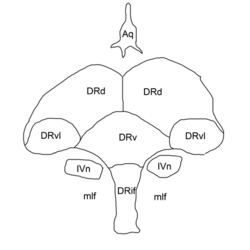Dorsal raphe nucleus
| Dorsal raphe nucleus | |
|---|---|

Outline of the nucleus raphes dorsalis: DRif interfascicular subnucleus, DRv ventral subnucleus, DRvl ventrolateral subnucleus, DRd dorsal subnucleus, mlf medial longitudinal fasciculus, Aq cerebral aqueduct, IVn trochlear nucleus.
|
|
| Details | |
| Identifiers | |
| Latin | nucleus raphes posterior, nucleus raphes dorsalis |
| NeuroNames | hier-503 |
| NeuroLex ID | Dorsal raphe nucleus |
| Dorlands /Elsevier |
n_11/12582845 |
| TA | A14.1.05.604 |
| FMA | 68462 |
|
Anatomical terms of neuroanatomy
[]
|
|
The dorsal raphe nucleus is located on the midline of the brainstem and is part of the raphe nucleus, consisting of the rostral and caudal subdivisions.
An increased number of cells in the lateral aspects of the dorsal raphe is characteristic of humans and other primates.
The dorsal raphe is the largest serotonergic nucleus and provides a substantial proportion of the serotonin innervation to the forebrain.
Serotonergic neurons are found throughout the dorsal raphe nucleus and tend to be larger than other cells. A substantial population of cells synthesizing substance P are found in the rostral aspects, many of these co-express serotonin and substance P. There is also a population of catecholamine synthesizing neurons in the rostral dorsal raphe, and these cells appear to be relatively large.
The dorsal raphe nucleus is rich in pre-synaptic serotonin 5-HT1A autoreceptors, and it's believed that the action of the selective serotonin reuptake inhibitors (SSRIs) in this region is responsible for the latency of their antidepressant effect.
Ten percent of the axons from the nucleus raphe dorsalis of the rat have been shown to project to the amygdala, while only medium cells seem to project to the caudate and putamen and olfactory bulb.
The nucleus raphes dorsalis has also been implicated in naloxone-induced morphine withdrawal. It is known that endogenous opioid receptors exist on the nucleus raphes dorsalis, and that it is a focal point as an ascending and descending regulator. Pourshanazari et al. showed in their 2000 paper that electrical stimulation of the nucleus raphes dorsalis can partially alleviate morphine withdrawal symptoms via electrical stimulation of the raphe nucleus in question.
These are fascinating results; however no control was provided for the spread of electrical charge to other parts of the brain stem. It is quite possible that the charge spread to the nucleus raphes magnus and induced analgesia upon the rats. Knowing that the spread of charge across such a short area is very plausible, as is an alternate connection to the raphe magnus, these results could be called into question.
...
Wikipedia
